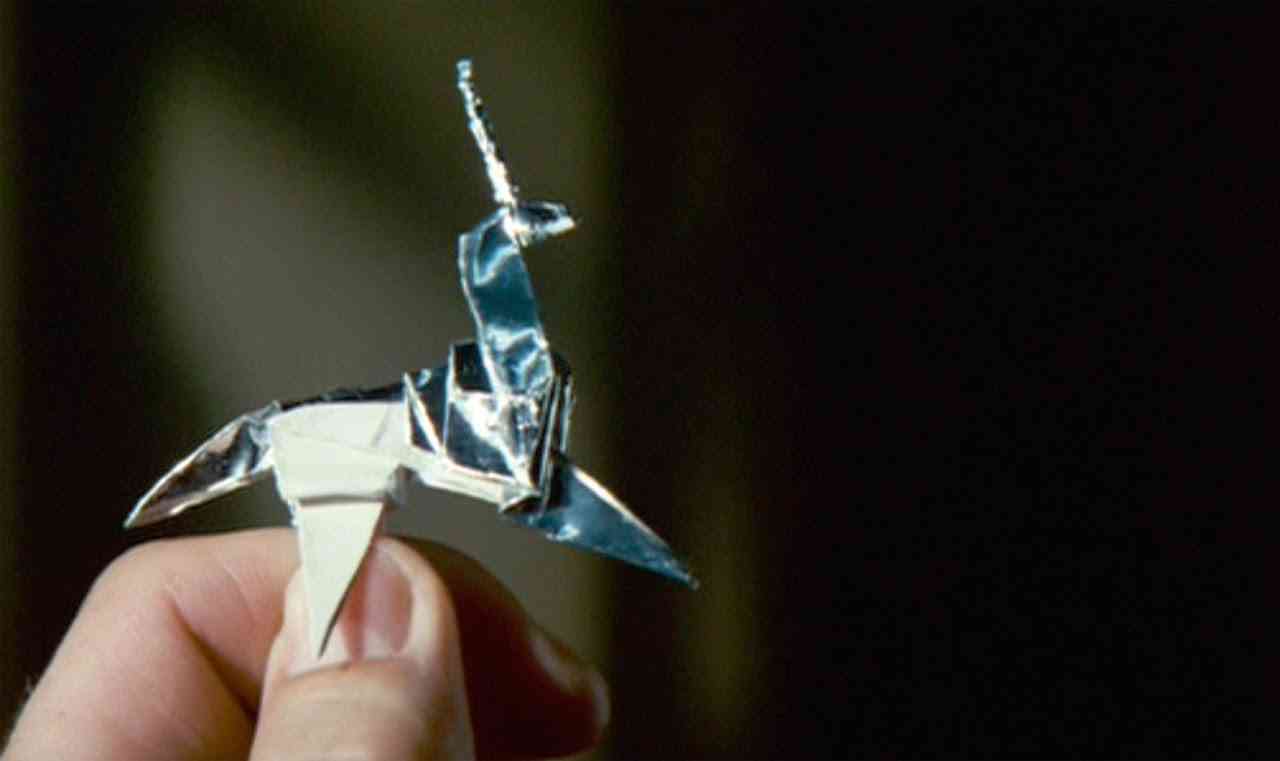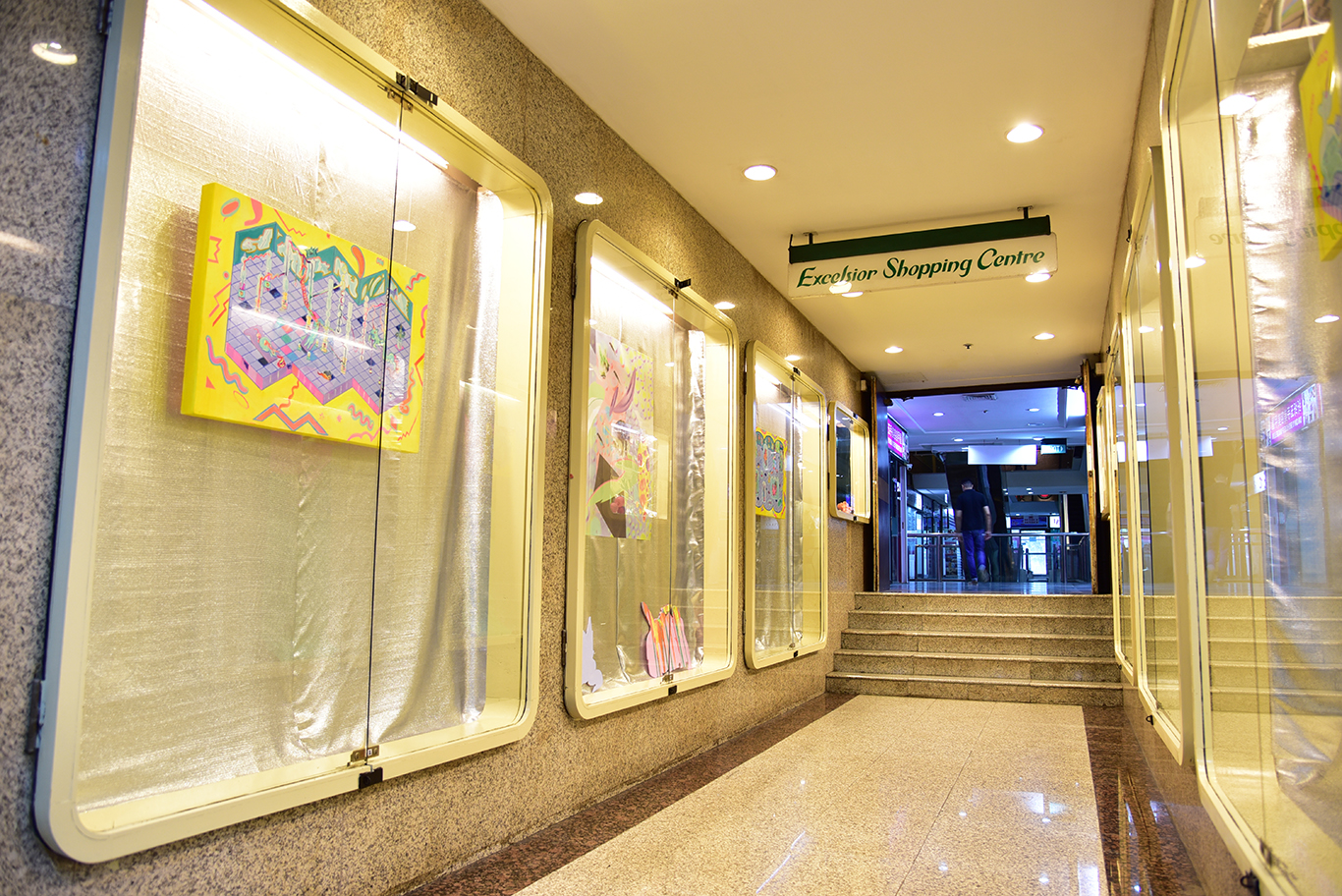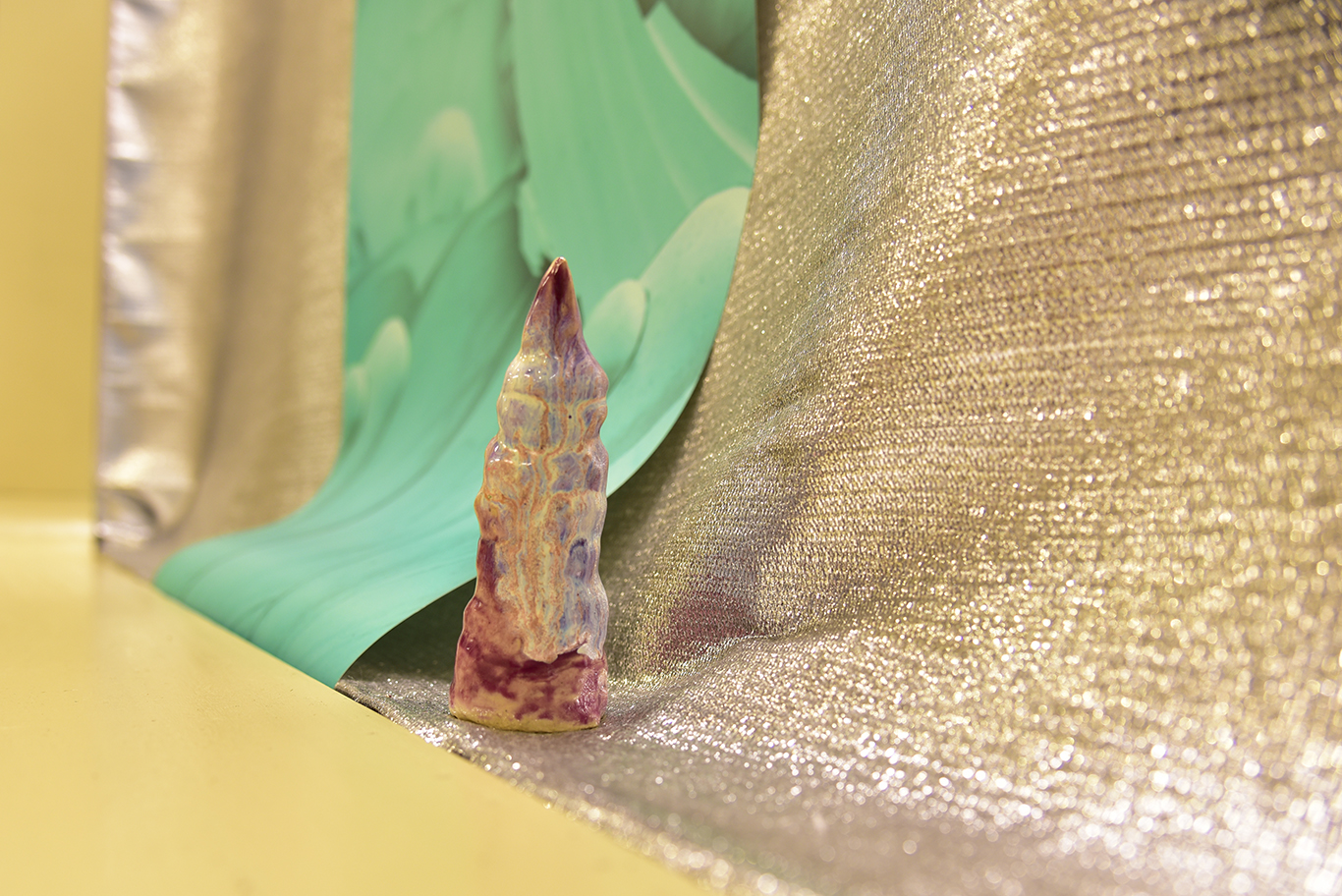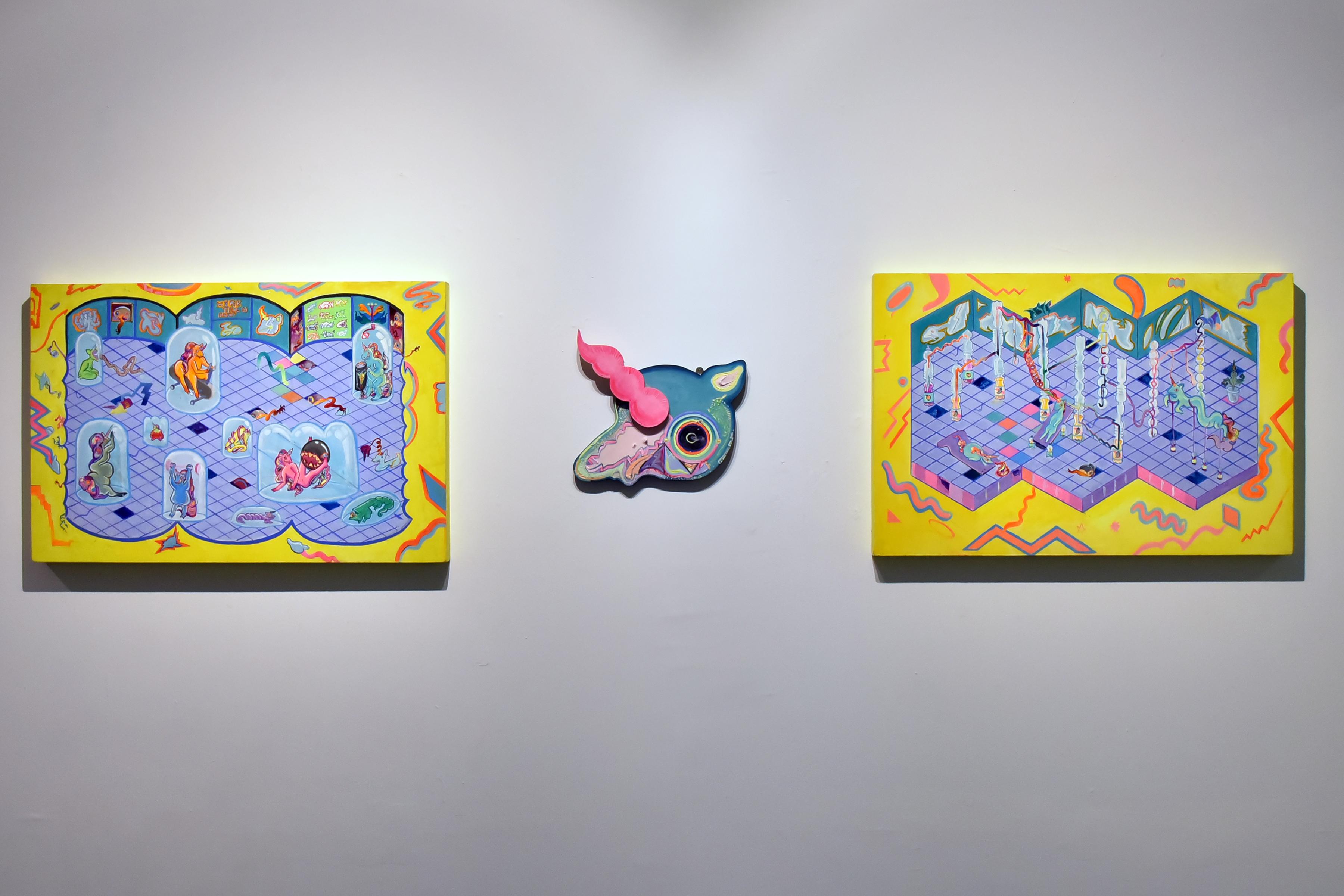Kass is an emerging interdisciplinary artist who dwells in the complexities of myths through a metamodern lens. Drawing inspiration from speculative themes of science fiction, ancient mythology, video games, board games, and comic books, Kass creates alternate realms that expand upon the imagination and dialogue of personal myths and archetypes.
Increasingly, we see artists wearing multiple hats at once. Artists are also curators, writers, makers and thinkers. Kass exemplifies this method of working at the intersections. In between delivering artworks and installing artworks, the artist managed to find some time to speak with us about how the year has unfolded for her thus far, and where she sees herself moving towards. Kass’ selection of objects and works for our conversation is a motley crew. Ranging from paintings, to books, to historical artefacts and pop culture references — it reflects the layered multiplicity that her works embody.
Increasingly, we see artists wearing multiple hats at once. Artists are also curators, writers, makers and thinkers. Kass exemplifies this method of working at the intersections. In between delivering artworks and installing artworks, the artist managed to find some time to speak with us about how the year has unfolded for her thus far, and where she sees herself moving towards. Kass’ selection of objects and works for our conversation is a motley crew. Ranging from paintings, to books, to historical artefacts and pop culture references — it reflects the layered multiplicity that her works embody.


¹ Imperial Yellow Kesi Twelve-Symbol Dragon Robe
Jiaqing Period (1796-1820)
You picked out a set of Chinese robes that were made during the Qing Dynasty’s Jiaqing period for this conversation. These robes are laden with symbolism, not just in terms of the actual images that are embroidered onto the robes, but also in terms of colour, craftsmanship, form and purpose. Tell me more about what you find interesting about this robe, and why you picked it out for our conversation. Do you see yourself wielding images or symbols as devices in your own works?
There are three main reasons I am drawn to this robe. Firstly, I’m attracted its use of the imperial colour — yellow. The robe is a brilliant yellow colour, and yellow was a colour reserved for the emperor. I was also drawn to the robe because of its depiction of the dragon, which is a mythical creature. Finally, I’m drawn to the rich symbolism associated to the robe itself and what wearing the robe would have implied.
With my own works, I do see myself using images and symbols as well. However, I use these images on a more personal level. I tap into iconographies that are specific to our local context, and fashion my own characters as well. You could even say that some of these characters function as alter egos.
These alter egos allow me to navigate and make sense of the metaphysical worlds I’m exploring in my works.
Instead of just exploring these ideas immediately through your own perspective, why was it important for you to mediate that through alter egos?
That’s something I’m still trying to wrap my head around. I don’t believe in exploring issues through the perspective of a single, one-dimensional entity. When we get too caught up in the idea of the self, it can blindside us a little. We might start seeing things through the perspective of polarities. In reality, the self is constantly evolving. The self is in flux and it changes all the time. The “I” can manifest in many forms. If we get stuck into seeing things through the self, it could produce a very monolithic point of view. When I use alter egos, I see it as creating expanded world views.
A lot of people have asked me about the unicorns in my work, because there isn’t a singular unicorn that appears across all of my paintings. All of the unicorns are different — they vary in expression, shape, size and form. In my observations of the unicorn as a mythical creature, I’ve noticed that the unicorn functions almost as a mutable vessel. Throughout the course of history, the unicorn shapeshifts in relation to time, cultural context and symbolic meaning.

² Gaff’s Unicorn
1982, Still from Blade Runner
Another item you picked out for our interview is Gaff’s Unicorn, which was featured in the movie, Blade Runner. As a mythical creature, everyone has a slightly different concept of what a unicorn looks like or what it symbolises. Personally, what do you enjoy about working with the unicorn as a symbol and why has it captured your imagination?
To be honest, I was inspired to begin using unicorns in my work after listening to a speech by the Prime Minister in 2015 during the lead up to the General Elections in Singapore. In the speech, the Prime Minister likened Singapore to the unicorn in that we were special. It got me thinking about the symbolism around a unicorn, and what it means to be a unicorn in a place like Singapore.
So what does being a unicorn in a country like Singapore mean? Does it mean being different or being unique?
I think those are the clichéd or conventional understandings around what that phrase would mean, but I wanted to draw upon how the unicorn was proliferated as a unifying symbol. On the one hand, we are asked to see ourselves as a collective unicorn, as set apart from the rest of the world; yet in unifying a people, it creates a dividing force that leads to disparities as well. There is this push and pull between an in crowd and an out crowd. That’s what I find incredibly interesting about the unicorn as a symbol.
An interesting parallel to draw to how the unicorn has been used as a symbol in the context of Singapore is the idea of superheroes. Superheroes are said to be different to the normal common folk because they have particular or extraordinary abilities. Yet, it is uncommon for two superheroes to share the same power. There is a great loneliness in being set apart. In this case, it almost seems as if one is a unicorn amidst a group of unicorns.

³ The Garden of Earthly Delights, Hieronymus Bosch
Museo Nacional del Prado, c. 1503–1515

⁴ The Stack, Benjamin H. Bratton
Two of the works you’ve picked out for our conversation, Hieronymus Bosch’s The Garden of Earthly Delights and Benjamin H. Bratton’s The Stack, structure a world view through planes, strata and layers. Some of the themes that you’ve explored in your work, such as postmodern identities and social anxieties, have a certain thickness and indeterminance around them. We were talking about division and subdivision earlier, and I was wondering if you’ve adopted a similar framework in approaching these complex issues in your work?
When it comes to structuring a world view, I’m definitely still in a phase of exploration. For example, The Stack was a book that was only recently introduced to me by the multimedia artist, Teow Yue Han. I was doing a presentation at Your MOTHER Gallery for my Unicorn Tears exhibition, and Yue Han did a response to my work that referenced The Stack and a couple of sci-fi books.
I’m still trying to digest the book and its ideas, so my thoughts about this book have not materialised within my works just yet. To be honest, I think these ideas are going to seep into the works that I’ll be making from here on out. I see it taking me into another dimension and another phase. Right now, I’m engaging with these topics in a more macro sense. I’m interested in going into a more granular or micro level to consider things such as statistics or data. I do see myself adopting a metamodel that oscillates between the macro and the micro.
This is just an example of what I’m reading now, and I’m hoping it’ll help to push my practice to the next frontier. These are things that I hadn’t thought of before, so I’m really glad that someone pointed it out to me. It’s difficult to verbalise it fully now because I’m still figuring things out. With The Stack, I just have this instinctive feeling that it’s going to be really important in shaping how I see my practice in future.
Let’s talk about your choice of the exhibition Superflat, which was held at The Museum of Contemporary Art (MoCA) in 2001. What drew you towards picking out this particular exhibition as compared to, for example, a particular work of Murakami’s?
I picked out this exhibition because this was an exhibition that highlighted Japanese artists who worked towards a two-dimensionality. The exhibition included works by Takashi Murakami, Hanmaru Machino and Chiho Aoshima. Some of these works are rather controversial in nature as well, and I feel like my works share an affinity with some of them.
I also have been told that there are elements of my work that resemble those by Murakami, especially in terms of the playfulness of the work and the use of characters. If you look at Murakami’s work, you’ll notice that he uses characters in most of them. Some of the characters he has invented include Mr. DOB, Kaikai and Kiki. In a way, the possibilities afforded by these characters are almost self-generating. There isn’t a clear endpoint or goal in sight. It’s similar to what I’m doing with my unicorns.
⁵ You aren’t living without a good fight!, Kass
2018
⁶ Sometimes I feel like a slippery creature, Kass
2018
2018
⁶ Sometimes I feel like a slippery creature, Kass
2018

⁷ Superflat
2001, Installation View at the Museum of Contemporary Art (MoCA)
It’s interesting that you point out that similarity. I think one main difference between your work and Murakami’s is that he alternates between the characters he uses. As of this interview, you’ve worked primarily with unicorns. You spoke about the endless possibilities afforded to an artist when one works with characters, but is it possible to exhaust these options when working with a single character or symbol?
I don’t think there can be an end. It is similar to being given a piece of paper and being asked to doodle on it. There are an infinite number of ways to doodle, and the doodles can go on for eternity. I don’t think I have a particular intention in using unicorns, but it isn’t a mindless endeavour either.
Having said that, I think this could seem like I’m contradicting myself a little. When you look at some of my previous works, I think there is a very clear sense of an ideology that underlies how and why I use unicorns. I could give you an answer as to where I stand today, but this could completely shift tomorrow. As I said earlier, the self is in a constant state of flux and I think this manifests in a certain turbulence around how I approach my paintings.
⁸ Bittersweet Chimeric Dreams, Kass
2019
2019
Another interesting point about your works is that you paint on wood quite often. In a number of these works, you don’t paint over the wood, which leaves the material quite exposed. Wood isn’t always a neutral background. This is particularly so when you compare it to store bought canvases. Wood comes with its own colour, grain and texture, and some surfaces can be uneven as well. Is there a particular quality about painting on wood that you really enjoy?
![]()
I’m drawn to painting on wood because of its organic qualities. I paint with acrylic paints, and I quite like the contrast created by working with manmade paints and natural wood. I’ve always enjoyed observing the grain that runs through wood. There is this rather calming effect in looking at its ripples and following its contours. In comparison to this, a white canvas can be rather striking and stark. A blank canvas can be terrifying, especially because it feels like you can’t make any mistakes on it. When I sketch or paint on wood, I don’t feel that same sense of fear.
I also enjoy referencing the relationship between the artificial and the natural within the materials I use. I think it really brings out the notion of myths that I explore in my works. Myths are stories that emerge from the human mind and imagination, yet they draw heavily from our natural environment. For example a unicorn closely resembles a horse, but has been reimagined to have a long horn that extends from its forehead.
I’m drawn to painting on wood because of its organic qualities. I paint with acrylic paints, and I quite like the contrast created by working with manmade paints and natural wood. I’ve always enjoyed observing the grain that runs through wood. There is this rather calming effect in looking at its ripples and following its contours. In comparison to this, a white canvas can be rather striking and stark. A blank canvas can be terrifying, especially because it feels like you can’t make any mistakes on it. When I sketch or paint on wood, I don’t feel that same sense of fear.
I also enjoy referencing the relationship between the artificial and the natural within the materials I use. I think it really brings out the notion of myths that I explore in my works. Myths are stories that emerge from the human mind and imagination, yet they draw heavily from our natural environment. For example a unicorn closely resembles a horse, but has been reimagined to have a long horn that extends from its forehead.
⁹ Strange Unicorns, Kass
2019, Installation View at PIP’s PLAYbox
Photography: Esplanade – Theatres on the Bay, Singapore
2019, Installation View at PIP’s PLAYbox
Photography: Esplanade – Theatres on the Bay, Singapore
Creating artwork for children seems like it would make for a completely different experience to creating work for older audiences and your work, Strange Unicorns, is currently in PIP’s PLAYbox — the Esplanade’s children arts space. With Strange Unicorns, did you approach the process of art making any differently? How did you find the experience of creating artworks for children like?
With Strange Unicorns, I wanted to encourage children to really indulge their imaginative senses. The work is an open invitation into an exploration of what the unicorn is or can be. The unicorns in this work don’t really look like the polished and beautiful unicorns you see depicted in picture books. Their bodies are distorted, and you can even describe some of them as looking rather grotesque. Some of the unicorns look very rugged, and they don’t look that magical either.
I painted these unicorns on wooden blocks, and I wanted them to resemble wooden children’s toys. I wanted the children to draw links between the shape of these wooden blocks and the shapes they see around them. It is important that the children are able to pick up these blocks, play with them, and learn to associate these blocks to things they are familiar with.
When I started working on this project, I proposed creating works that had socio-political connotations to them. It soon became clear that this was not suitable for the space or its intended audience, and that I had to fine tune my ideas. Looking back now, I think I still managed to reference Mikhail Bakhtin’s idea of the Carnivalesque in this work. I didn’t set out with an intention to, so that’s quite interesting.
There is a strong emphasis on the imaginative and the imaginary in Strange Unicorns, and you use elements such as a vibrant colour palette to further excite and engage children with the work. Have you been able to observe children interacting with the work? What are their responses are to it?
I created some patterns on wood boards, and the children are able to trace out these outlines by placing an activity sheet over the board and applying pressure onto the sheet with a crayon. I do see the children using the frottage boards quite a bit, and they seem to enjoy this process of mark making.Initially, I wanted to give the children free rein. I wanted them to draw a unicorn, whatever they might understand that to be, without dictating that idea to them. However that lack of framework proved rather unfeasible, so we eventually decided on the Western conception of a unicorn as the point of departure for this work.
¹⁰ Unicorn Tears, Kass
2018, Installation View at I_S_L_A_N_D_S
2018, Installation View at I_S_L_A_N_D_S


Mikhail Bakhtin’s idea of the Carnivalesque is a theory you’ve been thinking about for awhile now, and you spoke about referencing it even within a work made for children. Could you give us a sense of how you came across the theory, how you understand it, and whether it has energised your practice in any way?
I first came across Bakhtin’s Carnivalesque whilst doing research for my dissertation in 2016. My dissertation was on the reinvention of the self, particularly through the perspective of the carnival. I’ve always been trying to push the idea of what it means to live within a conservative environment like Singapore. I’ve always wanted to challenge conventions through my works, and theories such as the Carnivalesque have helped me do that.
It goes without saying that there are a lot of limitations to living in a country such as Singapore. One could toy with communist ideas and propose overthrowing the establishment in favour of the proletariat, but communism in its pure form is unrealistic.
Through my paintings, I offer a vision of what a world without these constraints could look like. We can often theorise about these ideas, but what would they visually look like?
Bakhtin was writing about a very different geopolitical clime to what we in Singapore experience. I didn’t translate his writings wholesale into my works, and drew only upon some of the points he made, particularly the points that I felt were relevant. He forwarded the notion of the grotesque body and the creation of a world turned upside-down. These were some of the things that I found useful and that I’ve found myself referencing. Having said that, I haven’t gone back to that text in awhile. Despite that, I do see it creeping into some of the recent works I’ve made.
¹¹ Unicorn Tears, Kass
2018, Installation View at I_S_L_A_N_D_S
2018, Installation View at I_S_L_A_N_D_S


Finally, I wanted to talk about your involvement in the Singapore Utopia exhibition at Chan + Hori Contemporary. As mentioned earlier, your works are interested in the myths surrounding how identities are constructed. How will these interests manifest in the artworks you will be exhibiting, particularly since it will be read in relation to the specific context of the Bicentennial happenings and its narratives?
I’ve always thought of the Bicentennial as a sort of spectacle. I think it’s quite ironic that I’m part of the Singapore Utopia exhibition because of how the unicorn functions as a commentary on this spectacle. There is this tension between wanting to go against an established system, yet finding that same system inescapable.
I’ll be showing three paintings at the exhibition, and two of them are old works that have been shown elsewhere before. The two paintings were shown at I_S_L_A_N_D_S, in some display cases along a walkway between Peninsula and Excelsior Shopping Centre. When I first painted them, I made them with the intention of commenting on the process of visual merchandising. Now that it is placed in the context of a gallery, I think that function changes a little. Although Chan + Hori is a commercial gallery as well, the exhibition is set against the backdrop of the Bicentennial. This dissolves the initial premise of the two artworks slightly, and reframes them in relation to new questions and concerns.
As to how these works are actually reframed, it remains to be said. I need to see the paintings installed in the space, and in relation to the works done by the other exhibiting artists. There will also be some performances happening over the course of the exhibition. Right now, I’m looking at it in isolation and it feels a little abstract.
It’s been quite a year of making work and showing year for you. Do you foresee any other projects on the horizon for the rest of the year, or do you see yourself taking a break for a bit to rethink the direction of your practice?
I think I’ll definitely take some time out to rethink certain things. I’ll still be making new works, but I probably won’t be exhibiting any of them anytime soon. I hope to apply for an artist’s residency next year as well. Residencies are really good spaces for artists to consolidate their thoughts and to just concentrate on making work. Apart from going overseas on a travel award, I haven’t actually been on a residency before. I’m hoping to stay in a particular area, and to just focus on making art for awhile.
¹² Various Works, Kass
2018-2019, Installation View at Singapore Utopia, Chan + Hori Contemporary
Photography: Chan + Hori Contemporary
2018-2019, Installation View at Singapore Utopia, Chan + Hori Contemporary
Photography: Chan + Hori Contemporary


Singapore Utopia is now open.
The exhibition will run at Chan + Hori Contemporary until 1 September 2019.
More information about the exhibition can be found here.
The exhibition will run at Chan + Hori Contemporary until 1 September 2019.
More information about the exhibition can be found here.
